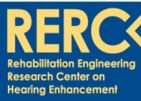Overview – Training Video – Download – Instructions – Development – Contact
Development
Speech Tracking was first introduced as an auditory training technique by DeFilippo and Scott (1978). The KTH computer-assisted method of Speech Tracking uses an algorithm created at the Royal Institute of Technology in Sweden (KTH) by Gnospelius and Spens (1992). This was modified in 2007 into a computerized program by the Rehabilitation Engineering Research Center (RERC) on Hearing Enhancement at Gallaudet University in collaboration with Dr. Harry Levitt and Chris Oden at Advanced Hearing Concepts, and Geoff Plant at MED-EL. Evidence-based citation on the use of KTH Speech Tracking is reported by Bernstein et al (2012).
Funding for the development of the software and instructional video on KTH Speech Tracking was provided by the National Institute on Disability and Rehabilitation Research, U.S. Department of Education, Grant #H133E030006 (RERC on Hearing Enhancement). The contents of the webpage were developed under a grant from the National Institute on Disability, Independent Living, and Rehabilitation Research ,Grant # 90RE5020. NIDILRR is a Center within the Administration for Community Living, U.S. Department of Health and Human Services.
Selected References
Bernstein, C., Brewer, D.*, Bakke, M., Olson, A., Machmer, E., Spitzer, J., Schauer,P., Sydlowski,S.,& Levitt,H. (2019). Maximizing Cochlear Implant Outcomes with Short-Term Aural Rehabilitation: Manuscript submitted for publication.* Co-First Authors
Plant, G., Bernstein, C., & Levitt, H. (2015). Optimizing Performance in Adult Cochlear Implant Users through Clinician Directed Auditory Training. Seminars in Hearing, 36, 2.
Bernstein, C., Bakke, M., Mazevski, A., Blake-Rahter, P., Presley, R., Hume, K., Plant, G., & Levitt, H. (2012). Benefits of Speech Tracking Training on Sentence Recognition, Tracking Rate, and Self-Assessed Communication Function in Adult Cochlear Implant Users. Journal of the Academy of Rehabilitative Audiology, 45, 11-39. 96-309.
Gnosspelius, J., & Spens, K. (1992). A computer based speech tracking procedure. Speech Transmission Laboratory Quarterly Progress and Status Reports, 1, 131-137.
DeFilippo, C., & Scott, B. (1978). A method for training and evaluating the reception of ongoing speech. Journal of the Acoustical Society of America, 63, 1186-1102.


